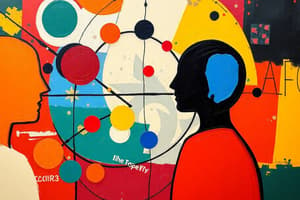Podcast
Questions and Answers
What does the 'S' in Berlo's SMCR model represent?
What does the 'S' in Berlo's SMCR model represent?
- Subject matter expertise
- Source's attitudes and knowledge (correct)
- Signal clarity
- Sender's abilities
In the Shannon-Weaver model, what is described as 'noise'?
In the Shannon-Weaver model, what is described as 'noise'?
- Feedback mechanism
- Effects of the receiver
- Signal interference (correct)
- Message content
Which of the following is a function of communication?
Which of the following is a function of communication?
- Behavior control (correct)
- Social isolation
- Elimination of barriers
- Message distortion
What does the 'R' in Berlo's SMCR model refer to?
What does the 'R' in Berlo's SMCR model refer to?
According to Barlund's model, what does the 'E' represent?
According to Barlund's model, what does the 'E' represent?
Which type of communication is identified as verbal?
Which type of communication is identified as verbal?
What is the primary focus of the transactional model of communication?
What is the primary focus of the transactional model of communication?
Which element is NOT part of the Shannon-Weaver model?
Which element is NOT part of the Shannon-Weaver model?
What is defined as the first language and mother tongue of a community?
What is defined as the first language and mother tongue of a community?
What is the main characteristic of linear communication?
What is the main characteristic of linear communication?
Which form of communication involves interacting with members of different races?
Which form of communication involves interacting with members of different races?
Which language register is characterized by normal conversation?
Which language register is characterized by normal conversation?
Who is known as the father of mass communication?
Who is known as the father of mass communication?
What term describes communication that is tradition-linked and tends to be indirect?
What term describes communication that is tradition-linked and tends to be indirect?
Which component does Lasswell's model of communication NOT include?
Which component does Lasswell's model of communication NOT include?
Which option is NOT a type of intercultural communication mentioned?
Which option is NOT a type of intercultural communication mentioned?
What is described as a potential barrier in the communication process?
What is described as a potential barrier in the communication process?
Eugene's model of communication is characterized by which of the following features?
Eugene's model of communication is characterized by which of the following features?
What does the 'field experience' refer to in communication models?
What does the 'field experience' refer to in communication models?
Which stage is NOT part of Aristotle's model of communication?
Which stage is NOT part of Aristotle's model of communication?
Which statement best summarizes the nature of communication?
Which statement best summarizes the nature of communication?
What is the definition of culture according to its learned aspect?
What is the definition of culture according to its learned aspect?
Which of the following best describes cultural integration?
Which of the following best describes cultural integration?
What does cultural assimilation entail?
What does cultural assimilation entail?
Which stage in the adaptation to new cultures could involve experiencing culture shock?
Which stage in the adaptation to new cultures could involve experiencing culture shock?
What is the term for unfair thoughts about a person due to race or other characteristics?
What is the term for unfair thoughts about a person due to race or other characteristics?
What is a potential negative impact of technology on communication?
What is a potential negative impact of technology on communication?
What does cultural accommodation involve?
What does cultural accommodation involve?
What does cultural diversity refer to?
What does cultural diversity refer to?
What is the main characteristic of the honeymoon phase in cultural adjustment?
What is the main characteristic of the honeymoon phase in cultural adjustment?
Which reaction best describes individuals who embrace a new culture?
Which reaction best describes individuals who embrace a new culture?
How long does the adjustment phase typically last?
How long does the adjustment phase typically last?
What type of culture shock involves difficulty in adapting back to the old culture?
What type of culture shock involves difficulty in adapting back to the old culture?
Which of the following is NOT a type of dialect?
Which of the following is NOT a type of dialect?
What is the main characteristic of a cosmopolitan reaction to culture?
What is the main characteristic of a cosmopolitan reaction to culture?
What does multiculturalism refer to?
What does multiculturalism refer to?
What is the term for a way of speaking that is unique to an individual?
What is the term for a way of speaking that is unique to an individual?
Flashcards are hidden until you start studying
Study Notes
Models of Communication
- Berlo’s SMCR Model: David Berlo (1949) proposed the source-message-channel-receiver (SMCR) model of communication. It emphasizes the sender's attitudes and knowledge, the message content and treatment, the channel through which the message is sent (primarily the senses), and the receiver's attitudes and knowledge.
- Transactional Model: This model emphasizes two-way communication, highlighting interpersonal communication. It includes elements like encoding, decoding, feedback, and context.
- Shannon-Weaver Model: Developed by Warren Weaver and Claude Shannon (1948), this model focuses on the telephone exchange and the concept of noise, which can disrupt communication. The model involves the information source, transmitter, receiver, destination, and feedback.
- Barlund’s Model: Dean Barlund (1970) proposed a circular, multi-layered feedback system model. It consists of the person, decoding, encoding, and message (M).
- Linear Communication: This model depicts communication as a one-way process, with the sender encoding a message that is then decoded by the receiver. It includes elements such as channel and noise.
- Lasswell's Model: Harold D. Lasswell (1948) presented one of the most influential communication models. It focuses on five key elements: Who (sender), Says What (message), Channel (medium), To Whom (receiver), and With What Effect (feedback).
- Aristotle’s Model: This early linear model, considered the first, emphasizes four elements: Speaker, Message, Audience, and Effect.
- Scramms Model: William Schramm (father of mass communication) included field experience as an influence on the understanding of the message.
- Eugene’s Model: This model is circular, representing communication as continuous with no beginning or end.
Functions of Communication
- Control: Communication can be used to influence and regulate behavior.
- Social Interaction: Communication facilitates interaction between individuals.
- Motivation: Communication inspires and encourages individuals.
- Emotional Expression: Communication allows individuals to convey their feelings and emotions.
- Information Dissemination: Communication serves to share and spread information.
Types of Communication
According to Mode
- Verbal Communication: Communication through spoken or written language.
- Nonverbal Communication: Communication through gestures, body language, facial expressions, and other non-verbal cues.
According to Purpose
- Purposive Communication: Communication with a specific objective or goal.
Cultural Communication
- Cultural Diversity: Societies with a wide range of cultures and ethnic groups.
- Intercultural Communication: Effective communication between individuals with different backgrounds.
- High-Context Culture: Communication embedded in context, often indirect.
- Low-Context Culture: Communication focused on explicit information, often direct.
Cultural Awareness and Sensitivity
- Cultural Awareness: Understanding and respecting the differences in cultures.
- Cultural Sensitivity: Demonstrating awareness of cultural differences and adapting communication accordingly.
Language Variety
- Dialect: Regional, social, or ethnic variations in language.
- Accent: The pronunciation of words by individuals or groups.
- Creole: A language developed from a pidgin, often becoming the native language of a community.
- Pidgin: A simplified language developed for communication between speakers of different languages.
Language Registers
- Formal: Communication used in formal settings like business presentations.
- Informal: Communication used in casual interactions with friends and family.
- Frozen: Communication in fixed form, like prayers or legal documents.
- Consultative: Communication where one person offers advice.
- Intimate: Communication between those in close relationships.
British English vs. American English
- British English and American English are two major variations of the English language.
- Both are mutually intelligible, but there are some differences in pronunciation, spelling, and vocabulary.
- The differences often reflect geographical, historical, and cultural influences.
Additional Notes
- Culture Shock: The feeling of unfamiliarity and discomfort when encountering a new culture.
- Prejudice: Unfair or biased thinking about individuals based on their race, age, gender, or other characteristics.
Impact of Technology on Communication
- Information Access: Technology provides access to a vast amount of information, contributing to a more informed society.
- Connection: Technology allows individuals to stay connected with friends and family, regardless of geographical location.
- Community Building: Online platforms create opportunities for individuals with shared interests to connect.
- Cultural Exchange: Technology facilitates the exchange of ideas and experiences between people from different cultures.
- Social Isolation: Technology can also contribute to social isolation if used excessively.
- Virtual Reality: Technology allows individuals to create virtual identities, blurring the lines between the real and the virtual world.
English as a Second/Foreign Language
- English as a Second Language (ESL): English is learned by individuals for whom it is not their native language, but is used in their current environment or society.
- English as a Foreign Language (EFL): English is learned by individuals for whom it is not their native language and is typically used for travel, study, or work.
Local & Global Communication in Multicultural Settings
- Multiculturalism: The presence of multiple cultures in a society.
- Inter-racial Communication: Communication between individuals of different races.
- Inter-ethnic Communication: Communication between individuals of different ethnic groups.
- International Communication: Communication between individuals from different nations.
- Intra-cultural Communication: Communication within a specific racial or ethnic group.
Studying That Suits You
Use AI to generate personalized quizzes and flashcards to suit your learning preferences.




